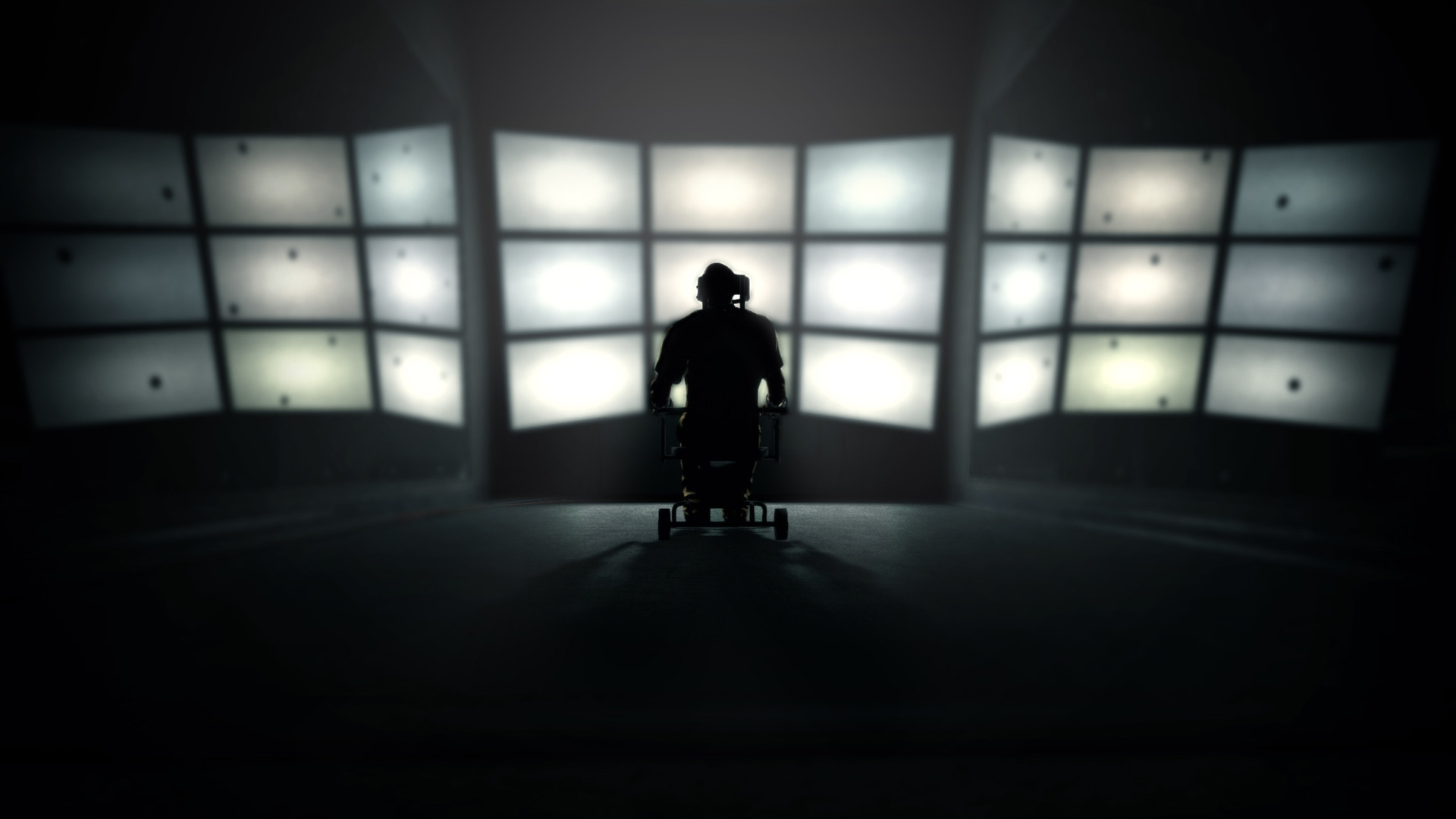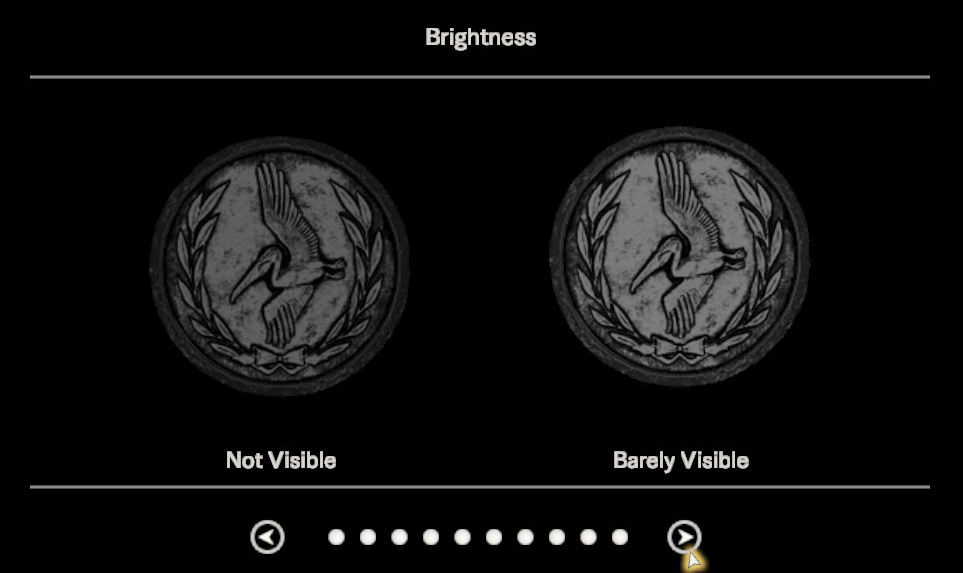Be honest: Do you crank up the brightness slider in horror games?
Are you scared of the dark? Or do you bravely respect the 'Adjust the slider until the logo is barely visible' directive?
It's mid-September, roughly the time when everyone starts turning their Twitter handles into spooky versions of their names in anticipation of Halloween (maybe I'll change Christoper Livingston into Hiss-chopper Deading-stunned). And as the leaves turn and the days grow shorter (or longer, if you live on the upside-down part of the globe) it's a good time to start thinking about horror games.
And most horror games begin by asking you to adjust your brightness levels. Specifically, it shows you a few icons and tells you to move a slider until one icon can't be seen or can barely be seen. It's basically saying, hey, we're gonna hide some very scary things in the dark, and you're going to help us do it.
Our question this week: Do you crank up the brightness in horror games? Be honest! It's okay if you're scared, because scary games are scary. Or do you respect the slider and the icons and do you best to help the game scare the crap out of you? Here are our answers. We'd love to see yours in the comments.

Tyler Wilde
I usually make it a smidgen brighter than suggested. It's not so much that I'm worried something is going to pop out of the darkness and make me spit Diet Coke on my keyboard, but that I don't like bumbling around in overly-dark hallways. Walking face first into walls or squinting to make out details is just tiring. If a flashlight is central to the game, and I'm really not supposed to see anything outside of the beam, then I might let it have its way. Otherwise, I like to have a vague sense of what's around me, even in the shadows. It's not as if something leaping out of those shadows and screaming in my face isn't going to level me anyway.
Jarred Walton
Pretty much ditto what Tyler said, but I do have an interesting anecdote to share. I remember when Doom 3 came out back in 2004, the game was horribly, unplayably dark. Jump scares worked a bit better, sure, but I walked off an unseen ledge and died multiple times. I hated it. I tried adjusting the brightness and it still sucked. I may have even ranted on some forums somewhere about how 'broken' the game was.
Several months later, I bought a new 24-inch 1920x1200 LCD, because I wanted one, and ditched my aging 21-inch CRT. Turns out all the "too dark to play" problems with Doom were because of my monitor. It was far better on the new LCD.
Andy Chalk
I try to set the slider as the developer recommends, although I usually end up notching it a wee bit higher to avoid having to strain my eyes too much. This led to confusion recently when I misread the Control brightness instructions and made the middle triangle invisible, after which I spent a few hours bumping into things and wondering why the game was so damn dark before I finally had enough. Then I discovered that there are actually three triangles, not two, and boy that makes a big difference. Whoops!
Anyway, I love sneaking around in dark levels (even when there are unpleasant things hiding in them) and do my best to embrace the intended ambiance as fully as possible, but not at the expense of comfort.
The biggest gaming news, reviews and hardware deals
Keep up to date with the most important stories and the best deals, as picked by the PC Gamer team.

Joanna Nelius
I do agree that having a good monitor is essential to the horror game experience; there is absolutely such as thing as too dark. But monitors aside, cranking up the brightness ruins the mood of the game. Lighting is so important when you're trying to create a certain experience for the player, jump scares or not. Yes, horror games are scary, but that's the point. Outlast wouldn't be Outlast with the brightness cranked all the way up.
Alice Newcome-Beill
When I play a horror game I know what I signed up for. I like to keep it as dark as I possibly can. Heck, when I played Alien: Isolation I turned on my camera and mic to just add to the immersion. The biggest problem I run into though isn't the game being too dark, it's screen glare. Unless I can get my environment to be pitch black in the middle of the day, I run into the issue of not being able to make out what's on-screen because things are too reflective. For that reason specifically, I've invested in blackout shades and typically reserve my gaming for the twilight hours.
Chris Livingston
Wow, so far, everyone is very brave. Fine, I'll say it, I crank that shit up as high as I can without making the game look all washed-out and terrible.
I like the tension of horror games, I like spooky things, but I do not like jump scares. And I'm certainly not going to help the game out by making an icon 'barely visible' or 'not visible'. That's me volunteering for a future jump scare! FPS games don't have a slider telling me to adjust it until my head is completely out of cover so it can shoot me more easily. Racing games don't ask me to move a slider until my car is almost out of gas. You want to scare me, video game? Fine. But I'm not going to help you.
Evan Lahti
My biggest tale of Brightness Shame comes from the earliest days of DayZ, when cranking up the gamma allowed you to see in the dark. Well, a brightened, grey version of it, anyway. It sort of turned DayZ into a black-and-white film. Anyway, in my defense, DayZ was unpredictable and downright broken in its first weeks and months: zombies could Kitty Pryde through walls, collision detection and netcode were unreliable, and, you know, you couldn't see shit in the dark. The downside to configuring your gamma in this way was that if a friend or enemy lit a flare, it absolutely flooded your screen with light.
Morgan Park
Wow, now I know why I was constantly getting shot in complete darkness in DayZ!
Since I am a human with morals, I generally don't mess with brightness settings to gain an advantage. I'm sure there's some setting I could tweak in Siege to see players better in dark corners, but the game's look would really suffer for it. Same goes for singleplayer games. In fact, more darkness can make for a fun challenge. Last year, I installed a mod for MGSV that cranked down the brightness at night. Darker nights encouraged me to actually use my night vision goggles to see long distances and made night infiltrations more exhilarating. This adventure led me to generally lowering the brightness from the default in games more often, just to see if it adds anything interesting. In Gears 5, it was cool to really need the light of my robo-companion Jack to find hidden weapons.
Phil Savage
I tend to crank up the brightness, but it's only partially because I'm a big scaredy cat. It's because I spent years working on the magazine, and nothing looks worse than a page full of screenshots so dark that you can't make out any details. And so, yes, Thief might be a game about finding comfort in the shadows, but I tend to play in blinding brightness purely for the benefit of anybody who spent £6 with the intention of being able to see the games we write about.
OK, fine, it's mostly because I'm a big scaredy cat.

Chris started playing PC games in the 1980s, started writing about them in the early 2000s, and (finally) started getting paid to write about them in the late 2000s. Following a few years as a regular freelancer, PC Gamer hired him in 2014, probably so he'd stop emailing them asking for more work. Chris has a love-hate relationship with survival games and an unhealthy fascination with the inner lives of NPCs. He's also a fan of offbeat simulation games, mods, and ignoring storylines in RPGs so he can make up his own.

